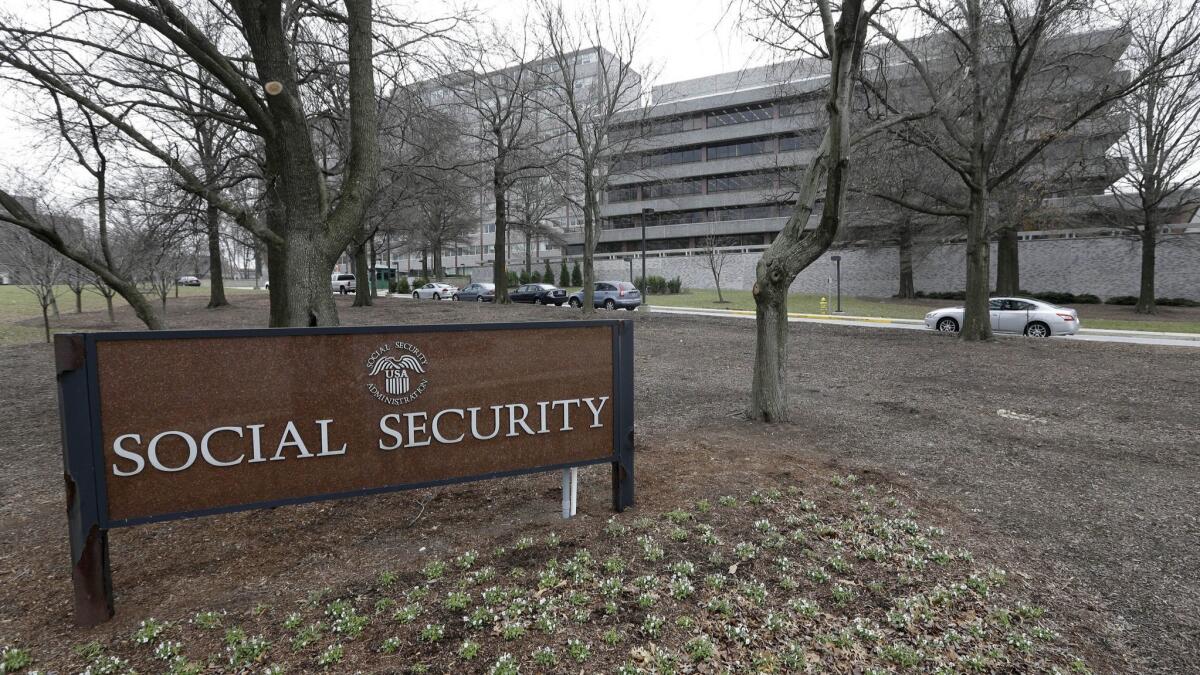Editorial: Social Security and Medicare are in danger? Nothing to see here, says Trump’s Treasury secretary

- Share via
Trustees overseeing Social Security and Medicare issued yet more warnings this week about the worsening financial health of the programs. In response, Treasury Secretary Steven T. Mnuchin told Americans not to worry — the rip-roaring economic growth the Trump administration is whipping up will take care of everything!
Except that it won’t, and pretending that the looming funding shortfalls will magically fix themselves is irresponsible and cowardly.
The reality is that the aging U.S. population leaves a decreasing number of workers to pay the payroll taxes that cover the cost of Social Security’s retirement and disability benefits and Medicare’s hospital coverage. President Trump’s decision to end the Deferred Action for Childhood Arrivals program exacerbated that problem by reducing the number of workers paying those taxes. That should be easy enough to fix: Congress could simply restore DACA. Oh, wait.
Meanwhile, Medicare is being strained not only by a burgeoning population of retirees, but also by healthcare costs that are growing faster than inflation or the economy. The Affordable Care Act had a mechanism to address this — an expert panel that would recommend ways to rein in costs without rationing care — but the GOP Congress killed the panel before its members could be appointed.
This administration seems to have the stomach only for pandering to its base with handouts and protectionist tariffs.
So here’s what the numbers say now. The Social Security Trust Fund has started to shrink, with tax revenues and interest no longer covering the annual cost of benefits to about 62 million Americans. By 2034, the trustees estimate, it will be gone, forcing benefits to be cut by nearly one quarter.
The problems in Medicare are more immediate, according to that program’s trustees. The trust fund supporting Medicare’s hospital benefits is expected to run dry in only eight years, or three years sooner than the trustees had previously projected. Without that trust fund, hospital benefits would face steeper and steeper cuts, starting at 9% in 2026 and growing to 22% in 2040. Other parts of Medicare face similar budgetary challenges.
Washington has a number of options. Congress could take steps that raise the revenue coming into the Social Security Trust Fund — for example, by applying payroll taxes to more of a person’s annual wages (the cutoff now is $128,400) or to more types of income than just wages. It could also take steps that reduce the amount of money flowing out of the trust fund — for example, by raising the age at which people can collect full retirement benefits. Similarly, for Medicare, it could bring in more money (through higher payroll tax rates, for example), or it could work more aggressively to tamp down healthcare costs.
The problems have been evident for more than a decade, yet lawmakers have been loath to take steps that could raise taxes or cut benefits. The longer lawmakers wait to make any of these moves, however, the more dramatic the changes will have to be in order to eliminate the shortfall. That’s not politics, that’s math.
Mnuchin’s prescription? Count on tax cuts, deregulation and the administration’s whipsaw trade moves to “generate the long-term growth needed to help secure these programs and lead them to a more stable path.” Yes, and tax cuts pay for themselves, bank regulations caused the sub-prime mortgage fiasco, climate change is a Chinese hoax and there really was a pedophile ring operating out of that pizza restaurant in Washington, D.C.
That’s a dangerous fantasy. This administration seems to have the stomach only for pandering to its base with handouts and protectionist tariffs. It doesn’t have the guts to confront the difficult fiscal problems that threaten the programs relied on by millions of older Americans.
Follow the Opinion section on Twitter @latimesopinion and Facebook.
More to Read
A cure for the common opinion
Get thought-provoking perspectives with our weekly newsletter.
You may occasionally receive promotional content from the Los Angeles Times.






